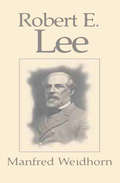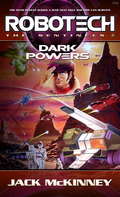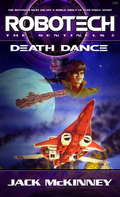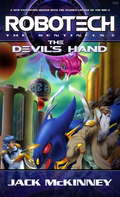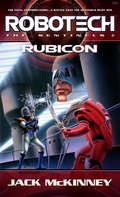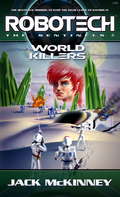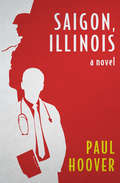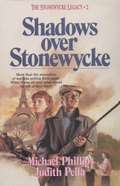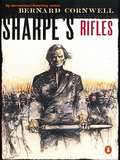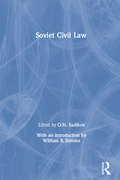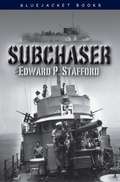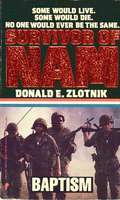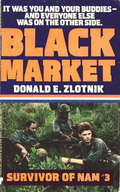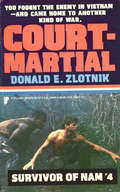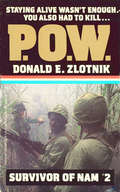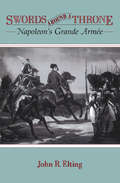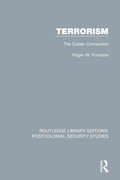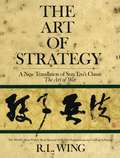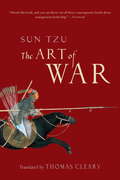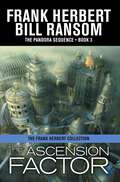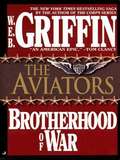- Table View
- List View
Robert E. Lee
by Manfred WeidhornRobert E. Lee's life has been regarded as one of great honor and esteem and he has been a man admired for his loyalty, patriotism, and conduct as not only an American, but also a Virginian. And when he made the decision to turn down Lincoln's offer to command a large army of Union Soldiers in the war against the secession, and instead chose to extend his loyalty to the Confederate Army, his intentions were to defend his land and the people in Virginia and not to fight for either secession or slavery. Lee's patriotism of an unfamiliar shade confused some, but made consequential waves in the Civil War. He followed in the footsteps of his father, a Revolutionary War General, and is here portrayed by Weidhorn as the "finest general of the Civil War", a title he honorably earned.
Robotech: Dark Powers
by Jack MckinneyThe Robotech Expeditionary Force had been stranded on the far side of the galaxy as the result of damage to their Super Dimensional Fortress during the battle with the Invid hordes. Their chances for survival were slim.Suddenly, a starship unlike anything that had ever flown before appeared -- manned by an incredible assortment of beings who meant to challenge the might of the Invid Regent himself!REF volunteers signed aboard, with their might war mecha in tow, for a campaign that would either mean the total destruction of the freedom fighters or liberty for the planets of -- The Sentinels.
Robotech: Death Dance
by Jack MckinneyMarooned On A Doomed World!Four months passed without a word from the Sentinels, and the members of the Expeditionary Mission to Tirol were beginning to fear the worst. This, even as they entered into truce negotiations with the being who might have been responsible for the destruction of the Sentinels' starship -- the Invid Regent himself.Meanwhile, the survivors of the Farrago remained hopelessly stranded on Praxis, a planet in cataclysm, hastened to endtime by the dark designs of the Invid Regis. But deep within that world's transformed core were answers to the Sentinels' prayers; if they could only reach them before Praxis tore itself apart. For Rick and Lisa Hunter, Cabell, and the others, the moment had arrived for desperate actions...And Time Was Running Out!
Robotech: Devil's Hand (Robotech #13)
by Jack MckinneyIt was 2020. Six years had passed since the destruction of the Super Dimensional Fortresses 1 and 2, that final tragedy of the First Robotech War. But Earth was on the mend now, and from the wreckage of those ships the Robotech Defense Force had succeeded in fashioning a new battle fortress -- the SDF-3. Its mission: to cross the galaxy and make peace with Tirol's Robotech Masters.It sounded straightforward enough; but unknown to Admirals Rick and Lisa Hunter and their crew of thousands, the Robotech Masters were already on their way to Earth!Nevertheless Tirol would have a greeting in store for the Expeditionary Mission: an incendiary salute from the warlord whose hordes had conquered half the galactic Quadrant -- the Invid Regent! Threatened with a swift and violent end, and suddenly torn by internal struggles for power, the RDF would find itself thrust into a savage war for survival!
Robotech: Rubicon
by Jack MckinneyOptera! Birthplace of the Flowers of Life and their agents of retribution, the Invid . . . nexus for an unfolding of events that had left the galaxy reshaped and redefined . . . and now the focal point of the Sentinels' long campaign to liberate the Quadrant from the Regent's tyranny.Edwards is on his way to Optera, in flight from Tirol with his prisoner Lynn-Minmei and a handful of Invid Inorganics under his control. So too are Breetai's Zentraedi -- closing on the very world the Imperative bade them defoliate generations ago -- and the renegade forces of Tesla, mutated beyond recognition by the fruits of the Flower.The Sentinels themselves are not far behind. However, they have Peryton to deal with first -- a godforsaken planet cursed by fate and time itself. But what awaits Rick, Lisa, and the Human Sentinels there is a mere primer for what is to come: the realization that they have journeyed across the galaxy . . . to wage war against each other!
Robotech: World Killers
by Jack MckinneyThe bearlike Karbarrans and the swashbuckling amazons from Praxis, the feral natives of Garuda and the Human Robotech heroes -- these oddly -- met champions banded together with other races, from other planets, to form the Sentinels.Yet what fighting force could hope to dislodge the Invid hordes from Haydon IV, ethereal world of superscience and hidden emotional conflict; or Spheris, crystalline globe of living minerals and murderous resonances?The Sentinels launch their attack nevertheless; they've come too far to surrender to tyranny. But the treachery of a megalomanic Human general and a mutating Invid P.O.W. make the war seem hopeless.The Sentinels battle on, though, because for them it's...Victory or Death!
Saigon, Illinois: A Novel
by Paul HooverThe story of how one man wound up fighting the Vietnam War from a Chicago hospitalYoung slacker Jim Holder wants no part of the draft, the army, or Vietnam. So he registers as a conscientious objector and gets ready for alternative service. He&’s assigned to work as a unit manager at a downtown Chicago medical center, worlds apart from his rural roots. A wild assortment of patients and colleagues awaits him at Metropolitan Hospital. As Jim&’s life swings from the chaos of his job to the fervor of a revolutionary moment, he balances his beliefs with the everyday business of life and death.In this richly comic novel, Paul Hoover crystallizes the strange days of the conflict in Vietnam with a memorable cast of characters.
Saigon, Illinois: A Novel
by Paul HooverThe story of how one man wound up fighting the Vietnam War from a Chicago hospitalYoung slacker Jim Holder wants no part of the draft, the army, or Vietnam. So he registers as a conscientious objector and gets ready for alternative service. He&’s assigned to work as a unit manager at a downtown Chicago medical center, worlds apart from his rural roots. A wild assortment of patients and colleagues awaits him at Metropolitan Hospital. As Jim&’s life swings from the chaos of his job to the fervor of a revolutionary moment, he balances his beliefs with the everyday business of life and death.In this richly comic novel, Paul Hoover crystallizes the strange days of the conflict in Vietnam with a memorable cast of characters.
Shadows over Stonewycke (Stonewycke Legacy #2)
by Judith Pella Michael R. PhillipsBook 2 of The Stonewycke Legacy is set shortly before the outbreak of World War II. Espionage and intrigue, tragedy, and restoration.
Sharpe's Rifles
by Bernard CornwellBernard Cornwell's action-packed series that captures the gritty texture of Napoleonic warfare--now beautifully repackagedIt's 1809, and Napoleon's army is sweeping across Spain. Lieutenant Richard Sharpe is newly in command of the demoralized, distrustful men of the 95th Rifles. He must lead them to safety--and the only way of escape is a treacherous trek through the enemy-infested mountains of Spain.
Sniper (Seals #10)
by Steve MackenzieIn the deadly world of modern warfare, the art of combat is taken to its awesome limits. Only one fighting unit has the skills and ruthlessness to handle all this power, making every corner of the globe its field of fire; using with chilling efficiency every method of infiltration, demolition, deception, and destruction this side of hell. They're Navy. Those who know about them speak in awed whispers of the men they call the... SEALS.<P> What started as a secret test was now a Navy nightmare! The project: probe the ESP communication capabilities of Tynan's troops. The result: short-tempered sailors who'd rather be fighting than telling fortunes. Except for one - who thinks he can actually see the future... and believes he must commit an atrocity to save the world. Mystic or madman, Tynan must stop him - whatever the cost.
Soviet Civil Law
by O.N. SadikovThis volume is an unabridged translation of the textbook ‘Soviet Civil Law’, originally published in 1983 under the auspices of the USSR Ministry of Justice. Edited by Professor O.N. Sadikov, the work includes contributions from nine Soviet legal scholars
Strike Force (Able Team #35)
by Dick Stivers Ron RenauldIt's a boyhood dream come true when Gadgets Schwarz takes part in a baseball camp featuring some of the game's best players. But the thrill is short-lived when he discovers that Doug Bendix, his baseball idol, is somehow involved in organized crime. Schwarz believes Bendix is being strong-armed by the mob. But when his colleagues join him, Able Team uncovers a drug operation that threatens to ignite an ethnic gang war. The temperature in Florida is ice-cold compared to the heat generated by Able Team when they drive this mission over the wall. But this game doesn't have extra innings-it's into sudden death overtime! Carl Lyons, Pol Blancanales and Gadgets Schwarz, three roaring avengers whose covert action squad is the fiercest in the world. Your life is in their hands!
Subchaser
by Edward P. StaffordIn a wartime Navy of giant carriers and battleships, tiny wooden subchasers did not command much attention. Yet these 110-foot warships, manned mostly by inexperienced reservists, performed vital chores for the fleet everywhere there was action in World War II. They led landing craft right up to the assault beaches, protected them from fire, fought off air attacks, swept for mines, laid down smoke screens, and patrolled the sea for killer submarines. One such doughty little ship, subchaser 692, is the subject of this book.Told by 692's commanding officer Ed Stafford, then a twenty-four-year-old lieutenant (jg) on his first warship, the story follows the thirty-man crew as they scrapped their way through the war, including action during the July 1943 invasion of Sicily. Filled with humor, tension, poignancy, and moments of high drama, this volume leaves today's readers with a vivid image of life on a very small ship in a very big war.
Survivor of Nam: Baptism - Book #1 (Survivor of Nam #1)
by Donald E. ZlotnikPrivate David Woods, newly arrived in Vietnam, faces his first bloody firefight and a deadly mission into Laos. Book 1 of Survivor of Nam.
Survivor of Nam: Black Market - Book #3 (Survivor of Nam #3)
by Donald E. ZlotnikBook 3 of this exciting Vietnam adventure series involves the military Black Market, where everything is for sale: contraband military supplies, drugs, booze, and even women. Now the time has come for the payoffs to stop and this chapter of the Black Market to be closed down for good.
Survivor of Nam: Court Martial - Book #4 (Survivor of Nam #4)
by Donald E. ZlotnikYou fought the enemy in Vietnam--and came home to another kind of war. Book 4 of Survivor of Nam by Donald E. Zlotnik.
Survivor of Nam: P. O. W. (Survivor of Nam #2)
by Donald E. ZlotnikThe second exciting book in this authentic series about Vietnam involves a 17-year-old corporal who is imprisoned by the Viet Cong and must endure the horrors of his capture until the U.S. Special Forces can rescue him. A super-heroic series, focusing on the grim realities of war.
Sword Point
by Harold CoyleGambling on hostile relations between Iran and the US, the Soviet Union invades Iran. America strikes back but when the Soviet onslaught is stopped by an American counter-attack, the superpowers discover that Iranian fanatics have a nuclear bomb ready to explode.
Swords Around A Throne: Napoleon's Grande Armée
by John R. EltingThis authoritative, comprehensive, and enthralling book describes and analyzes Napoleon's most powerful weapon -- the Grande Armee which at its peak numbered over a million soldiers. Elting examines every facet of this incredibly complex human machine: its organization, command system, logistics, weapons, tactics, discipline, recreation, mobile hospitals, camp followers, and more. From the army's formation out of the turmoil of Revolutionary France through its swift conquests of vast territories across Europe to its legendary death at Waterloo, this book uses excerpts from soldiers' letters, eyewitness accounts, and numerous firsthand details to place the reader in the boots of Napoleon's conscripts and generals. In Elting's masterful hands the experience is truly unforgettable.
Terrorism: The Cuban Connection
by Roger W. FontaineFirst published in 1988, Terrorism: The Cuban Connection examines Cuba’s involvement in terrorism. With a focus on Havana, the book begins by looking at Cuba’s history and the origins of terrorism. As it progresses, the book traces the development of terrorism and explores Cuba’s connections with other parts of the world, including America, Russia, the Caribbean, South America, the Middle East, and Sub-Saharan Africa. Terrorism: The Cuban Connection is a detailed study, equipped with a wealth of key documents and photographs.
The Art Of Strategy
by R. L. WingMore than 2,500 years ago, Sun Tzu composed his masterpiece The Art of War which has been used by the world's greatest leaders including Napoleon. Here, Wing makes the influential philosophies of the Orient accessible to all seekers of professional achievement and personal excellence.
The Art of War (Shambhala Library #909)
by Sun TzuConflict is an inevitable part of life, according to this ancient Chinese classic of strategy, but everything necessary to deal with conflict wisely, honorably, victoriously, is already present within us. Compiled more than two thousand years ago by a mysterious warrior-philosopher, The Art of War is still perhaps the most prestigious and influential book of strategy in the world, as eagerly studied in Asia by modern politicians and executives as it has been by military leaders since ancient times. As a study of the anatomy of organizations in conflict, The Art of War applies to competition and conflict in general, on every level from the interpersonal to the international. Its aim is invincibility, victory without battle, and unassailable strength through understanding the physics, politics, and psychology of conflict.
The Ascension Factor (Pandora Sequence #Bk. 2)
by Frank Herbert Bill Ransom&“This final collaboration between the late Herbert (Dune) and Ransom is a worthy sequel to their novel The Lazarus Effect.&” —Publishers Weekly Pandora&’s humans have been recovering land from its raging seas at an accelerated pace since The Lazarus Effect. The great kelp of the seas, sentient but electronically manipulated by humans, buffers Pandora&’s wild currents to restore land and facilitate the booming sea trade. New settlements rise overnight, but children starve in their shadows. An orbiting assembly station is near completion of Project Voidship, which is the hope of many for finding a better world. Pandora is under the fist of an ambitious clone from hibernation called The Director, who rules with a sadistic security force led by the assassin Spider Nevi. Small resistance groups, like the one led by Twisp Queets and Ben Ozette, have had little effect on his absolute power. The Director controls the transportation of foodstuffs; uprisings are punished with starvation. The resistance fighters&’ main hope is Crista Galli, a woman believed by some to be the child of God. Crista pools her talents with Dwarf MacIntosh, Beatriz Tatoosh, and Rico LaPush to transcend the barriers between the different species and overthrow The Director and the sinister cabal with which he rules. &“The details are fresh but the territory familiar . . . the fans won&’t pass this one up.&” —Kirkus Reviews, starred review &“Fans of the late [Frank Herbert] will not be disappointed. As with Herbert&’s famous Dune series, the novel boasts finely detailed characterizations and displays great concern for ecology.&” —Booklist &“A worthy sequel . . . wildly eclectic!&” —Rave Reviews
The Aviators: Book Eight Of The Brotherhood Of War Series (Brotherhood of War #8)
by W.E.B. GriffinIt is 1964. The Vietnam War has begun to escalate, its new style of battle demanding new weapons and tactics, and men who can use them. Overnight, it seems, the United States Army must scramble to create its first-ever Air Assault Division, a force critical to its chances of success. The obstacles are staggering--untrained men, technical mishaps, interservice rivalries. But through sheer courage and dedication, these heroic fighters rise to the challenge. For they are America's bravest--facing the ultimate test. . . .
